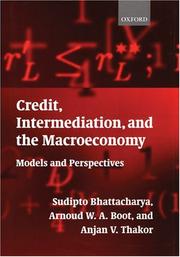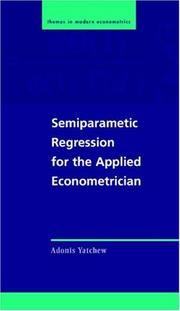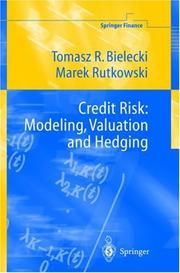| Listing 1 - 7 of 7 |
Sort by
|
Book
ISBN: 9781848551978 1848551975 1848551967 9786613681850 1280771089 9781848551961 9781848551961 9781280771088 6613681857 Year: 2008 Publisher: Bingley Emerald
Abstract | Keywords | Export | Availability | Bookmark
 Loading...
Loading...Choose an application
- Reference Manager
- EndNote
- RefWorks (Direct export to RefWorks)
The main theme of this volume is credit risk and credit derivatives. Recent developments in financial markets show that appropriate modeling and quantification of credit risk is fundamental in the context of modern complex structured financial products. The reader will find several points of view on credit risk when looked at from the perspective of Econometrics and Financial Mathematics. The volume consists of eleven contributions by both practitioners and theoreticians with expertise in financial markets, in general, and econometrics and mathematical finance in particular. The challenge of modeling defaults and their correlations is addressed, and new results on copula, reduced form and structural models, and the top-down approach are presented. After the so-called subprime crisis that hit global markets in the summer of 2007, the volume is very timely and will be useful to researchers in the area of credit risk.
Credit -- Mathematical models. --- Credit derivatives -- Mathematical models. --- Risk management -- Mathematical models. --- Credit derivatives --- Credit --- Econometrics --- Risk management --- Insurance --- Management --- Borrowing --- Finance --- Money --- Loans --- Derivative securities --- Mathematical models --- Quantitative methods (economics) --- International financial management --- Business & Economics --- Econometrics. --- Forecasting. --- Economics, Mathematical --- Statistics

ISBN: 0199243069 9780199243068 Year: 2004 Publisher: Oxford Oxford university press
Abstract | Keywords | Export | Availability | Bookmark
 Loading...
Loading...Choose an application
- Reference Manager
- EndNote
- RefWorks (Direct export to RefWorks)
Intermediation (Finance) --- Credit --- Mathematical models --- Management --- 336.7 --- -Credit --- -332.7015195 --- Borrowing --- Finance --- Money --- Loans --- Financial intermediation --- Geldwezen. Kredietwezen. Bankwezen. Financien. Monetaire econonomie. Beurswezen --- -Mathematical models --- Mathematical models. --- Intermediation (Finance). --- 336.7 Geldwezen. Kredietwezen. Bankwezen. Financien. Monetaire econonomie. Beurswezen --- 332.7015195 --- Management&delete& --- Credit - Mathematical models --- Credit - Management - Mathematical models
Book
ISBN: 3642442358 3642161138 3642161146 Year: 2011 Publisher: Heidelberg [Germany] : Springer,
Abstract | Keywords | Export | Availability | Bookmark
 Loading...
Loading...Choose an application
- Reference Manager
- EndNote
- RefWorks (Direct export to RefWorks)
The estimation and the validation of the Basel II risk parameters PD (default probability), LGD (loss given fault), and EAD (exposure at default) is an important problem in banking practice. These parameters are used on the one hand as inputs to credit portfolio models and in loan pricing frameworks, on the other to compute regulatory capital according to the new Basel rules. This book covers the state-of-the-art in designing and validating rating systems and default probability estimations. Furthermore, it presents techniques to estimate LGD and EAD and includes a chapter on stress testing of the Basel II risk parameters. The second edition is extended by three chapters explaining how the Basel II risk parameters can be used for building a framework for risk-adjusted pricing and risk management of loans.
Credit -- Mathematical models. --- Credit ratings -- Mathematical models. --- Risk -- Mathematical models. --- Finance --- Business & Economics --- Investment & Speculation --- Banking --- Finance - General --- Credit --- Risk --- Credit ratings --- Mathematical models. --- Commercial ratings --- Credit checks --- Credit guides --- Credit investigations --- Credit reports --- Ratings, Credit --- Finance. --- Management. --- Economics, Mathematical. --- Econometrics. --- Finance, general. --- Quantitative Finance. --- Economics, Mathematical --- Statistics --- Administration --- Industrial relations --- Organization --- Funding --- Funds --- Economics --- Currency question --- Economics, Mathematical . --- Mathematical economics --- Econometrics --- Mathematics --- Methodology
Book
ISBN: 3642156088 9786613080189 3642156096 1283080184 Year: 2011 Volume: 646 Publisher: Berlin : Springer Verlag,
Abstract | Keywords | Export | Availability | Bookmark
 Loading...
Loading...Choose an application
- Reference Manager
- EndNote
- RefWorks (Direct export to RefWorks)
This book considers the one-factor copula model for credit portfolios that are used for pricing synthetic CDO structures as well as for risk management and measurement applications involving the generation of scenarios for the complete universe of risk factors and the inclusion of CDO structures in a portfolio context. For this objective, it is especially important to have a computationally fast model that can also be used in a scenario simulation framework. The well known Gaussian copula model is extended in various ways in order to improve its drawbacks of correlation smile and time inconsistency. Also the application of the large homogeneous cell assumption, that allows to differentiate between rating classes, makes the model convenient and powerful for practical applications. The Crash-NIG extension introduces an important regime-switching feature allowing the possibility of a market crash that is characterized by a high-correlation regime.
Asset-backed financing. --- Collateralized debt obligations. --- Credit -- Mathematical models. --- Investment analysis. --- Finance --- Business & Economics --- Investment & Speculation --- Finance - General --- Banking --- Credit --- Mathematical models. --- CDOs (Collateralized debt obligations) --- Finance. --- Applied mathematics. --- Engineering mathematics. --- Economics, Mathematical. --- Finance, general. --- Quantitative Finance. --- Applications of Mathematics. --- Credit derivatives --- Mathematics. --- Math --- Science --- Funding --- Funds --- Economics --- Currency question --- Economics, Mathematical . --- Engineering --- Engineering analysis --- Mathematical analysis --- Mathematical economics --- Econometrics --- Mathematics --- Methodology --- Social sciences --- Financial Economics. --- Mathematics in Business, Economics and Finance.

ISBN: 0521812836 0521012260 0511064675 1280161205 0511120397 0511205988 0511296991 0511615884 0511073135 1107133106 9780511064678 9780511073137 9780521812832 9780521012263 9781280161209 9780511120398 9780511205989 9780511296994 9780511615887 Year: 2003 Publisher: New York Cambridge University Press
Abstract | Keywords | Export | Availability | Bookmark
 Loading...
Loading...Choose an application
- Reference Manager
- EndNote
- RefWorks (Direct export to RefWorks)
This book provides an accessible collection of techniques for analyzing nonparametric and semiparametric regression models. Worked examples include estimation of Engel curves and equivalence scales, scale economies, semiparametric Cobb-Douglas, translog and CES cost functions, household gasoline consumption, hedonic housing prices, option prices and state price density estimation. The book should be of interest to a broad range of economists including those working in industrial organization, labor, development, urban, energy and financial economics. A variety of testing procedures are covered including simple goodness of fit tests and residual regression tests. These procedures can be used to test hypotheses such as parametric and semiparametric specifications, significance, monotonicity and additive separability. Other topics include endogeneity of parametric and nonparametric effects, as well as heteroskedasticity and autocorrelation in the residuals. Bootstrap procedures are provided.
Econometrics --- Regression Analysis --- AA / International- internationaal --- 305.971 --- 303.5 --- Speciale gevallen in econometrische modelbouw. --- Theorie van correlatie en regressie. (OLS, adjusted LS, weighted LS, restricted LS, GLS, SLS, LIML, FIML, maximum likelihood). Parametric and non-parametric methods and theory (wiskundige statistiek). --- 330.115 --- Regression analysis --- Analysis, Regression --- Linear regression --- Regression modeling --- Multivariate analysis --- Structural equation modeling --- Economics, Mathematical --- Statistics --- Econometrie --- Credit -- Mathematical models. --- Econometrics. --- Regression analysis. --- Risk management -- Mathematical models. --- Business & Economics --- Economic Theory --- 330.115 Econometrie --- Theorie van correlatie en regressie. (OLS, adjusted LS, weighted LS, restricted LS, GLS, SLS, LIML, FIML, maximum likelihood). Parametric and non-parametric methods and theory (wiskundige statistiek) --- Speciale gevallen in econometrische modelbouw --- Business, Economy and Management --- Economics
Book
ISBN: 3642207200 3642207219 Year: 2011 Publisher: New York : Springer,
Abstract | Keywords | Export | Availability | Bookmark
 Loading...
Loading...Choose an application
- Reference Manager
- EndNote
- RefWorks (Direct export to RefWorks)
The aim of the book is to provide an overview of risk management in life insurance companies. The focus is twofold: (1) to provide a broad view of the different topics needed for risk management and (2) to provide the necessary tools and techniques to concretely apply them in practice. Much emphasis has been put into the presentation of the book so that it presents the theory in a simple but sound manner. The first chapters deal with valuation concepts which are defined and analysed, the emphasis is on understanding the risks in corresponding assets and liabilities such as bonds, shares and also insurance liabilities. In the following chapters risk appetite and key insurance processes and their risks are presented and analysed. This more general treatment is followed by chapters describing asset risks, insurance risks and operational risks - the application of models and reporting of the corresponding risks is central. Next, the risks of insurance companies and of special insurance products are looked at. The aim is to show the intrinsic risks in some particular products and the way they can be analysed. The book finishes with emerging risks and risk management from a regulatory point of view, the standard model of Solvency II and the Swiss Solvency Test are analysed and explained. The book has several mathematical appendices which deal with the basic mathematical tools, e.g. probability theory, stochastic processes, Markov chains and a tochastic life insurance model based on Markov chains. Moreover, the appendices look at the mathematical formulation of abstract valuation concepts such as replicating portfolios, state space deflators, arbitrage free pricing and the valuation of unit linked products with guarantees. The various concepts in the book are supported by tables and figures.
Credit -- Mathematical models -- Congresses. --- Credit derivatives -- Mathematical models -- Congresses. --- Econometrics -- Congresses. --- Risk management -- Mathematical models -- Congresses. --- Life insurance --- Finance --- Business & Economics --- Insurance --- Economic Theory --- Risk management --- Risk management. --- Insurance, Life --- Finance. --- Insurance. --- Applied mathematics. --- Engineering mathematics. --- Probabilities. --- Statistics. --- Macroeconomics. --- Macroeconomics/Monetary Economics//Financial Economics. --- Applications of Mathematics. --- Probability Theory and Stochastic Processes. --- Statistics for Business/Economics/Mathematical Finance/Insurance. --- Economics --- Statistical analysis --- Statistical data --- Statistical methods --- Statistical science --- Mathematics --- Econometrics --- Probability --- Statistical inference --- Combinations --- Chance --- Least squares --- Mathematical statistics --- Risk --- Engineering --- Engineering analysis --- Mathematical analysis --- Assurance (Insurance) --- Coverage, Insurance --- Indemnity insurance --- Insurance coverage --- Insurance industry --- Insurance protection --- Mutual insurance --- Underwriting --- Funding --- Funds --- Currency question --- Viatical settlements --- Mathematics. --- Distribution (Probability theory. --- Statistics for Business, Management, Economics, Finance, Insurance. --- Distribution functions --- Frequency distribution --- Characteristic functions --- Probabilities --- Math --- Science --- Statistics .

ISBN: 3540675930 9783540675938 3642087078 3662048213 Year: 2001 Publisher: Berlin Springer
Abstract | Keywords | Export | Availability | Bookmark
 Loading...
Loading...Choose an application
- Reference Manager
- EndNote
- RefWorks (Direct export to RefWorks)
Mathematical finance and financial engineering have been rapidly expanding fields of science over the past three decades. The main reason behind this phenomenon has been the success of sophisticated quantitative methodologies in helping professionals to manage financial risks. The newly developed credit derivatives industry has grown around the need to handle credit risk, which is one of the fundamental factors of financial risk. In recent years, we have witnessed a tremendous acceleration in research efforts aimed at better apprehending, modeling and hedging of this kind of risk. One of the objectives has been to understand links between credit risk and other major sources of uncertainty, such as the market risk or the liquidity risk. The main objective of this monograph is to present a comprehensive survey ofthe past developments in the area of credit risk research, as well as put forth the most recent advancements in this field. An important aspect of this text is that it attempts to bridge the gap between the mathematical theory of credit risk and the financial practice, which serves as the motivation for the mathematical modeling studied in the book. Mahtematical developments are presented in a thorough manner and cover the structural (value-of-the-firm) and the reduced-form (intensity-based) approaches to credit risk modeling, applied both to single and to multiple defaults. In particular, the book offers a detailed study of various arbitrage-free models of defaultable term structures with several rating grades. This book will serve as a valuable reference for financial analysts and traders involved with credit derivatives. Some aspects of the book may also be useful for market practitioners with managing credit-risk sensitives portfolios. Graduate students and researchers in areas such as finance theory, mathematical finance, financial engineering and probability theory will benefit from the book as well. On the technical side, readers are assumed to be familiar with graduate level probability theory, theory of stochastic processes, and elements of stochastic analysis and PDEs; some acquaintance with arbitrage pricing theory is also.
AA / International- internationaal --- 333.130.2 --- 305.7 --- 333.605 --- 333.70 --- 333.109 --- Bankliquiditeit. Verplichte reserves. Solvabiliteit. --- Econometrie van het gedrag van de financiële tussenpersonen. Monetaire econometrische modellen. Monetaire agregaten. vraag voor geld. Krediet. Rente. --- Nieuwe financiële instrumenten. --- Theorie en organisatie van het bankkrediet. --- Veiligheid. Bankovervallen. Bankrisico's. --- -Risk management --- Risk management --- Credit --- Mathematical models --- Mathematical models. --- Crédit --- Gestion du risque --- Modèles mathématiques --- Econometrie van het gedrag van de financiële tussenpersonen. Monetaire econometrische modellen. Monetaire agregaten. vraag voor geld. Krediet. Rente --- Veiligheid. Bankovervallen. Bankrisico's --- Bankliquiditeit. Verplichte reserves. Solvabiliteit --- Nieuwe financiële instrumenten --- Theorie en organisatie van het bankkrediet --- Public finance. --- Economics, Mathematical . --- Probabilities. --- Public Economics. --- Quantitative Finance. --- Probability Theory and Stochastic Processes. --- Probability --- Statistical inference --- Combinations --- Mathematics --- Chance --- Least squares --- Mathematical statistics --- Risk --- Economics --- Mathematical economics --- Econometrics --- Cameralistics --- Public finance --- Public finances --- Currency question --- Methodology --- Risk management - Mathematical models --- Credit - Mathematical models
| Listing 1 - 7 of 7 |
Sort by
|

 Search
Search Feedback
Feedback About UniCat
About UniCat  Help
Help News
News